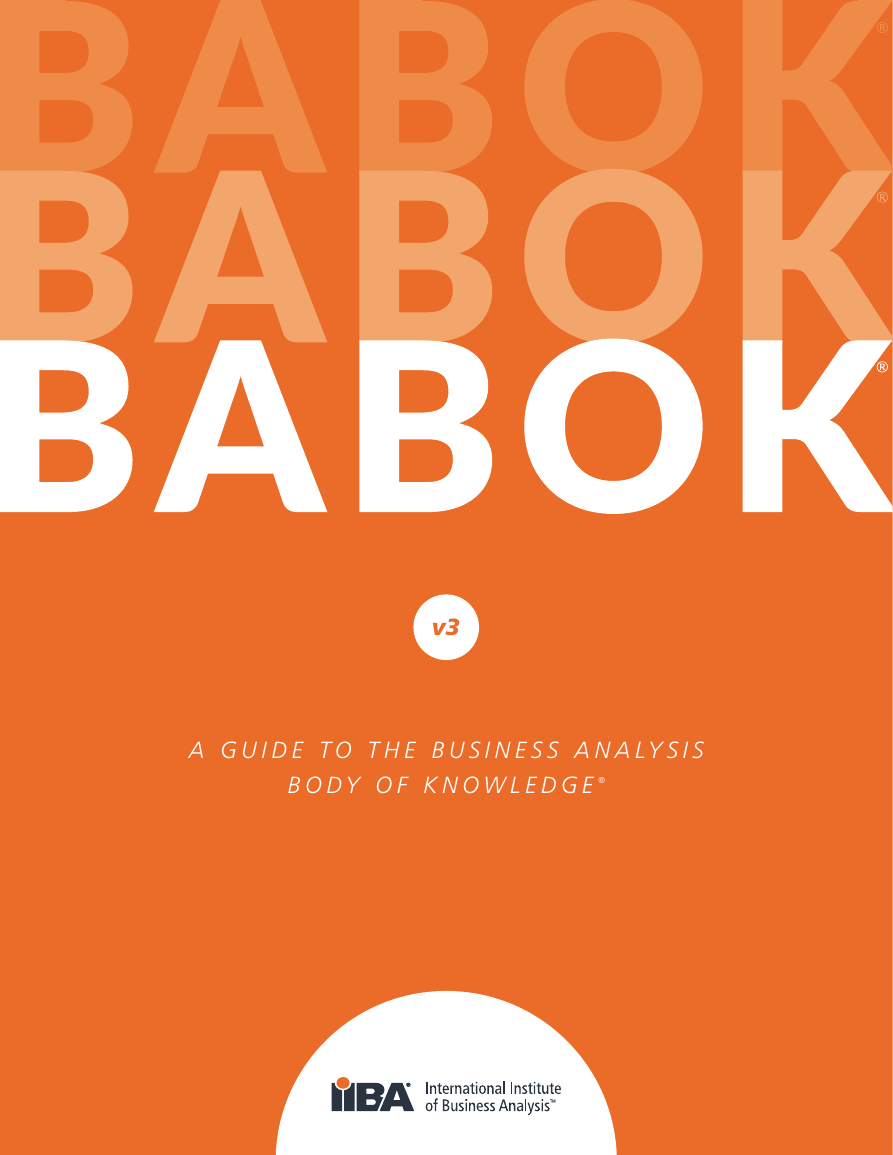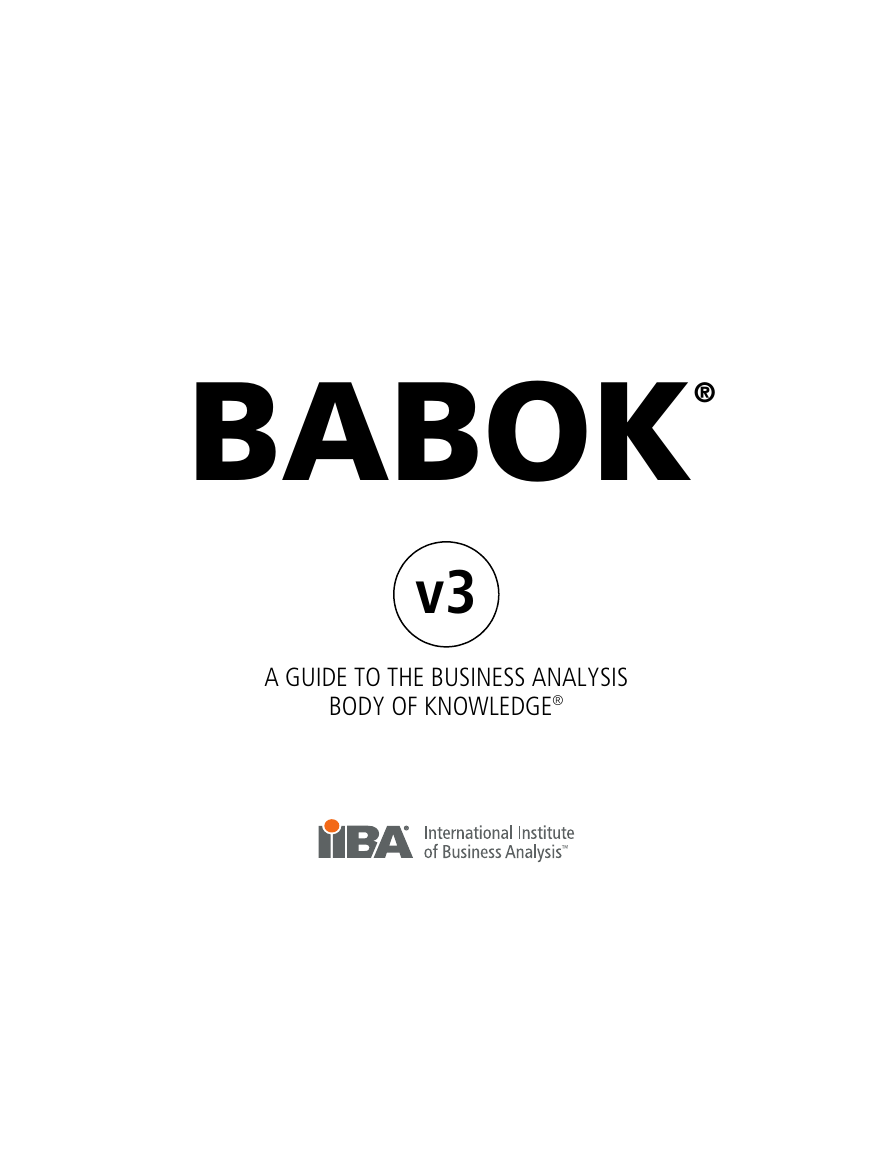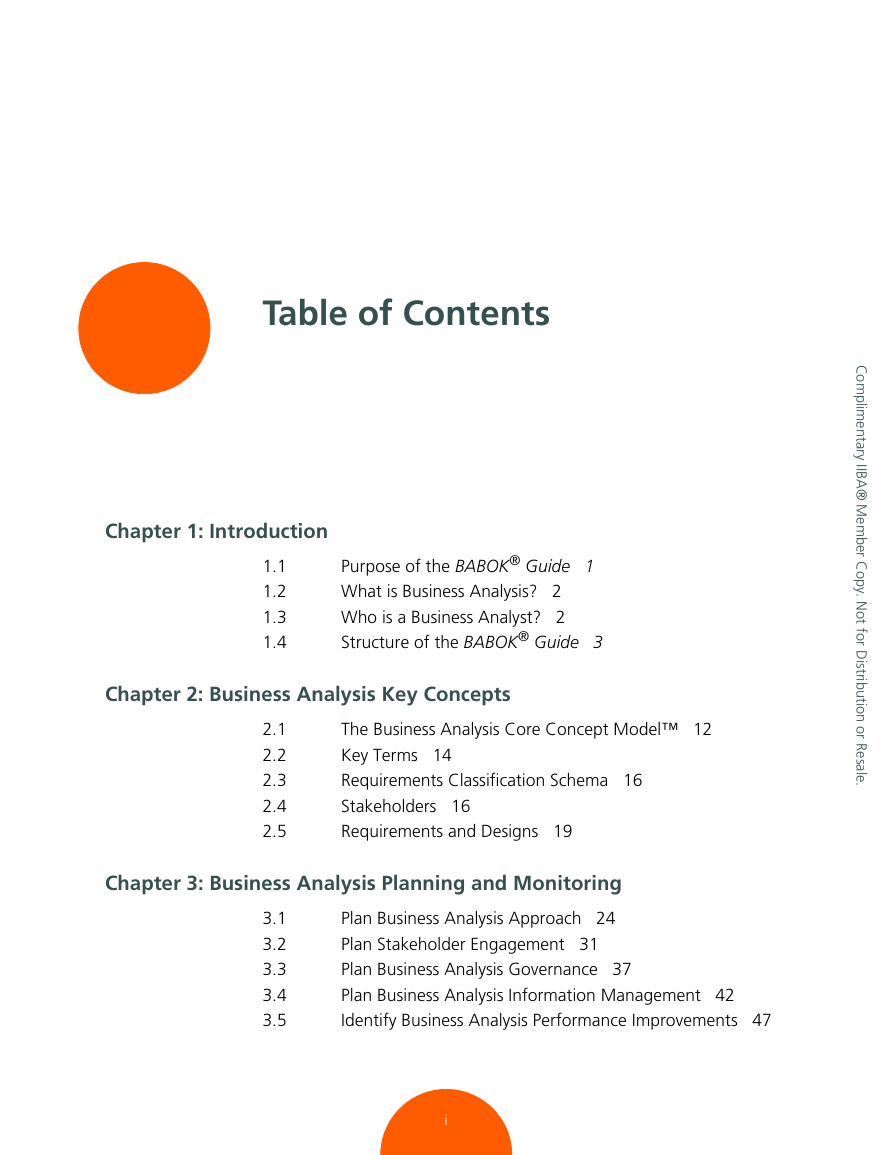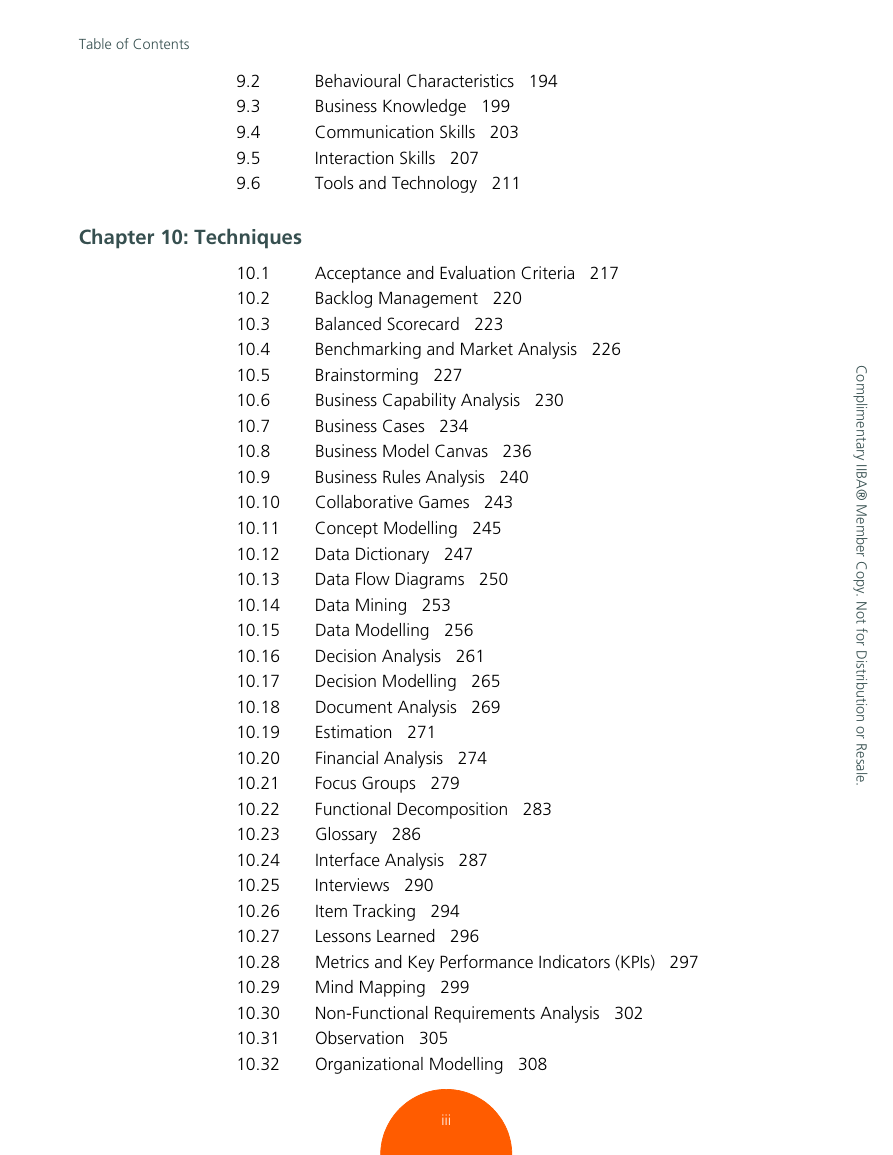Table of Contents
Introduction
1.1 Purpose of the BABOK® Guide
1.2 What is Business Analysis?
1.3 Who is a Business Analyst?
1.4 Structure of the BABOK® Guide
1.4.1 Key Concepts
1.4.2 Knowledge Areas
1.4.3 Tasks
1.4.4 Underlying Competencies
1.4.5 Techniques
1.4.6 Perspectives
Business Analysis Key Concepts
2.1 The Business Analysis Core Concept Model™
2.2 Key Terms
2.3 Requirements Classification Schema
2.4 Stakeholders
2.4.1 Business Analyst
2.4.2 Customer
2.4.3 Domain Subject Matter Expert
2.4.4 End User
2.4.5 Implementation Subject Matter Expert
2.4.6 Operational Support
2.4.7 Project Manager
2.4.8 Regulator
2.4.9 Sponsor
2.4.10 Supplier
2.4.11 Tester
2.5 Requirements and Designs
Business Analysis Planning and Monitoring
3.1 Plan Business Analysis Approach
3.1.1 Purpose
3.1.2 Description
3.1.3 Inputs
3.1.4 Elements
3.1.5 Guidelines and Tools
3.1.6 Techniques
3.1.7 Stakeholders
3.1.8 Outputs
3.2 Plan Stakeholder Engagement
3.2.1 Purpose
3.2.2 Description
3.2.3 Inputs
3.2.4 Elements
3.2.5 Guidelines and Tools
3.2.6 Techniques
3.2.7 Stakeholders
3.2.8 Outputs
3.3 Plan Business Analysis Governance
3.3.1 Purpose
3.3.2 Description
3.3.3 Inputs
3.3.4 Elements
3.3.5 Guidelines and Tools
3.3.6 Techniques
3.3.7 Stakeholders
3.3.8 Outputs
3.4 Plan Business Analysis Information Management
3.4.1 Purpose
3.4.2 Description
3.4.3 Inputs
3.4.4 Elements
3.4.5 Guidelines and Tools
3.4.6 Techniques
3.4.7 Stakeholders
3.4.8 Outputs
3.5 Identify Business Analysis Performance Improvements
3.5.1 Purpose
3.5.2 Description
3.5.3 Inputs
3.5.4 Elements
3.5.5 Guidelines and Tools
3.5.6 Techniques
3.5.7 Stakeholders
3.5.8 Outputs
Elicitation and Collaboration
4.1 Prepare for Elicitation
4.1.1 Purpose
4.1.2 Description
4.1.3 Inputs
4.1.4 Elements
4.1.5 Guidelines and Tools
4.1.6 Techniques
4.1.7 Stakeholders
4.1.8 Outputs
4.2 Conduct Elicitation
4.2.1 Purpose
4.2.2 Description
4.2.3 Inputs
4.2.4 Elements
4.2.5 Guidelines and Tools
4.2.6 Techniques
4.2.7 Stakeholders
4.2.8 Outputs
4.3 Confirm Elicitation Results
4.3.1 Purpose
4.3.2 Description
4.3.3 Inputs
4.3.4 Elements
4.3.5 Guidelines and Tools
4.3.6 Techniques
4.3.7 Stakeholders
4.3.8 Outputs
4.4 Communicate Business Analysis Information
4.4.1 Purpose
4.4.2 Description
4.4.3 Inputs
4.4.4 Elements
4.4.5 Guidelines and Tools
4.4.6 Techniques
4.4.7 Stakeholders
4.4.8 Outputs
4.5 Manage Stakeholder Collaboration
4.5.1 Purpose
4.5.2 Description
4.5.3 Inputs
4.5.4 Elements
4.5.5 Guidelines and Tools
4.5.6 Techniques
4.5.7 Stakeholders
4.5.8 Outputs
Requirements Life Cycle Management
5.1 Trace Requirements
5.1.1 Purpose
5.1.2 Description
5.1.3 Inputs
5.1.4 Elements
5.1.5 Guidelines and Tools
5.1.6 Techniques
5.1.7 Stakeholders
5.1.8 Outputs
5.2 Maintain Requirements
5.2.1 Purpose
5.2.2 Description
5.2.3 Inputs
5.2.4 Elements
5.2.5 Guidelines and Tools
5.2.6 Techniques
5.2.7 Stakeholders
5.2.8 Outputs
5.3 Prioritize Requirements
5.3.1 Purpose
5.3.2 Description
5.3.3 Inputs
5.3.4 Elements
5.3.5 Guidelines and Tools
5.3.6 Techniques
5.3.7 Stakeholders
5.3.8 Outputs
5.4 Assess Requirements Changes
5.4.1 Purpose
5.4.2 Description
5.4.3 Inputs
5.4.4 Elements
5.4.5 Guidelines and Tools
5.4.6 Techniques
5.4.7 Stakeholders
5.4.8 Outputs
5.5 Approve Requirements
5.5.1 Purpose
5.5.2 Description
5.5.3 Inputs
5.5.4 Elements
5.5.5 Guidelines and Tools
5.5.6 Techniques
5.5.7 Stakeholders
5.5.8 Outputs
Strategy Analysis
6.1 Analyze Current State
6.1.1 Purpose
6.1.2 Description
6.1.3 Inputs
6.1.4 Elements
6.1.5 Guidelines and Tools
6.1.6 Techniques
6.1.7 Stakeholders
6.1.8 Outputs
6.2 Define Future State
6.2.1 Purpose
6.2.2 Description
6.2.3 Inputs
6.2.4 Elements
6.2.5 Guidelines and Tools
6.2.6 Techniques
6.2.7 Stakeholders
6.2.8 Outputs
6.3 Assess Risks
6.3.1 Purpose
6.3.2 Description
6.3.3 Inputs
6.3.4 Elements
6.3.5 Guidelines and Tools
6.3.6 Techniques
6.3.7 Stakeholders
6.3.8 Outputs
6.4 Define Change Strategy
6.4.1 Purpose
6.4.2 Description
6.4.3 Inputs
6.4.4 Elements
6.4.5 Guidelines and Tools
6.4.6 Techniques
6.4.7 Stakeholders
6.4.8 Outputs
Requirements Analysis and Design Definition
7.1 Specify and Model Requirements
7.1.1 Purpose
7.1.2 Description
7.1.3 Inputs
7.1.4 Elements
7.1.5 Guidelines and Tools
7.1.6 Techniques
7.1.7 Stakeholders
7.1.8 Outputs
7.2 Verify Requirements
7.2.1 Purpose
7.2.2 Description
7.2.3 Inputs
7.2.4 Elements
7.2.5 Guidelines and Tools
7.2.6 Techniques
7.2.7 Stakeholders
7.2.8 Outputs
7.3 Validate Requirements
7.3.1 Purpose
7.3.2 Description
7.3.3 Inputs
7.3.4 Elements
7.3.5 Guidelines and Tools
7.3.6 Techniques
7.3.7 Stakeholders
7.3.8 Outputs
7.4 Define Requirements Architecture
7.4.1 Purpose
7.4.2 Description
7.4.3 Inputs
7.4.4 Elements
7.4.5 Guidelines and Tools
7.4.6 Techniques
7.4.7 Stakeholders
7.4.8 Outputs
7.5 Define Design Options
7.5.1 Purpose
7.5.2 Description
7.5.3 Inputs
7.5.4 Elements
7.5.5 Guidelines and Tools
7.5.6 Techniques
7.5.7 Stakeholders
7.5.8 Outputs
7.6 Analyze Potential Value and Recommend Solution
7.6.1 Purpose
7.6.2 Description
7.6.3 Inputs
7.6.4 Elements
7.6.5 Guidelines and Tools
7.6.6 Techniques
7.6.7 Stakeholders
7.6.8 Outputs
Solution Evaluation
8.1 Measure Solution Performance
8.1.1 Purpose
8.1.2 Description
8.1.3 Inputs
8.1.4 Elements
8.1.5 Guidelines and Tools
8.1.6 Techniques
8.1.7 Stakeholders
8.1.8 Outputs
8.2 Analyze Performance Measures
8.2.1 Purpose
8.2.2 Description
8.2.3 Inputs
8.2.4 Elements
8.2.5 Guidelines and Tools
8.2.6 Techniques
8.2.7 Stakeholders
8.2.8 Outputs
8.3 Assess Solution Limitations
8.3.1 Purpose
8.3.2 Description
8.3.3 Inputs
8.3.4 Elements
8.3.5 Guidelines and Tools
8.3.6 Techniques
8.3.7 Stakeholders
8.3.8 Outputs
8.4 Assess Enterprise Limitations
8.4.1 Purpose
8.4.2 Description
8.4.3 Inputs
8.4.4 Elements
8.4.5 Guidelines and Tools
8.4.6 Techniques
8.4.7 Stakeholders
8.4.8 Outputs
8.5 Recommend Actions to Increase Solution Value
8.5.1 Purpose
8.5.2 Description
8.5.3 Inputs
8.5.4 Elements
8.5.5 Guidelines and Tools
8.5.6 Techniques
8.5.7 Stakeholders
8.5.8 Outputs
Underlying Competencies
9.1 Analytical Thinking and Problem Solving
9.1.1 Creative Thinking
9.1.2 Decision Making
9.1.3 Learning
9.1.4 Problem Solving
9.1.5 Systems Thinking
9.1.6 Conceptual Thinking
9.1.7 Visual Thinking
9.2 Behavioural Characteristics
9.2.1 Ethics
9.2.2 Personal Accountability
9.2.3 Trustworthiness
9.2.4 Organization and Time Management
9.2.5 Adaptability
9.3 Business Knowledge
9.3.1 Business Acumen
9.3.2 Industry Knowledge
9.3.3 Organization Knowledge
9.3.4 Solution Knowledge
9.3.5 Methodology Knowledge
9.4 Communication Skills
9.4.1 Verbal Communication
9.4.2 Non-Verbal Communication
9.4.3 Written Communication
9.4.4 Listening
9.5 Interaction Skills
9.5.1 Facilitation
9.5.2 Leadership and Influencing
9.5.3 Teamwork
9.5.4 Negotiation and Conflict Resolution
9.5.5 Teaching
9.6 Tools and Technology
9.6.1 Office Productivity Tools and Technology
9.6.2 Business Analysis Tools and Technology
9.6.3 Communication Tools and Technology
Techniques
10.1 Acceptance and Evaluation Criteria
10.1.1 Purpose
10.1.2 Description
10.1.3 Elements
10.1.4 Usage Considerations
10.2 Backlog Management
10.2.1 Purpose
10.2.2 Description
10.2.3 Elements
10.2.4 Usage Considerations
10.3 Balanced Scorecard
10.3.1 Purpose
10.3.2 Description
10.3.3 Elements
10.3.4 Usage Considerations
10.4 Benchmarking and Market Analysis
10.4.1 Purpose
10.4.2 Description
10.4.3 Elements
10.4.4 Usage Considerations
10.5 Brainstorming
10.5.1 Purpose
10.5.2 Description
10.5.3 Elements
10.5.4 Usage Considerations
10.6 Business Capability Analysis
10.6.1 Purpose
10.6.2 Description
10.6.3 Elements
10.6.4 Usage Considerations
10.7 Business Cases
10.7.1 Purpose
10.7.2 Description
10.7.3 Elements
10.7.4 Usage Considerations
10.8 Business Model Canvas
10.8.1 Purpose
10.8.2 Description
10.9 Business Rules Analysis
10.9.1 Purpose
10.9.2 Description
10.9.3 Elements
10.9.4 Usage Considerations
10.10 Collaborative Games
10.10.1 Purpose
10.10.2 Description
10.10.3 Elements
10.10.4 Usage Considerations
10.11 Concept Modelling
10.11.1 Purpose
10.11.2 Description
10.11.3 Elements
10.11.4 Usage Considerations
10.12 Data Dictionary
10.12.1 Purpose
10.12.2 Description
10.12.3 Elements
10.12.4 Usage Considerations
10.13 Data Flow Diagrams
10.13.1 Purpose
10.13.2 Description
10.13.3 Elements
10.13.4 Usage Considerations
10.14 Data Mining
10.14.1 Purpose
10.14.2 Description
10.14.3 Elements
10.14.4 Usage Considerations
10.15 Data Modelling
10.15.1 Purpose
10.15.2 Description
10.15.3 Elements
10.15.4 Usage Considerations
10.16 Decision Analysis
10.16.1 Purpose
10.16.2 Description
10.16.3 Elements
10.16.4 Usage Considerations
10.17 Decision Modelling
10.17.1 Purpose
10.17.2 Description
10.17.3 Elements
10.17.4 Usage Considerations
10.18 Document Analysis
10.18.1 Purpose
10.18.2 Description
10.18.3 Elements
10.18.4 Usage Considerations
10.19 Estimation
10.19.1 Purpose
10.19.2 Description
10.19.3 Elements
10.19.4 Usage Considerations
10.20 Financial Analysis
10.20.1 Purpose
10.20.2 Description
10.20.3 Elements
10.20.4 Usage Considerations
10.21 Focus Groups
10.21.1 Purpose
10.21.2 Description
10.21.3 Elements
10.21.4 Usage Considerations
10.22 Functional Decomposition
10.22.1 Purpose
10.22.2 Description
10.22.3 Elements
10.22.4 Usage Considerations
10.23 Glossary
10.23.1 Purpose
10.23.2 Description
10.23.3 Elements
10.23.4 Usage Considerations
10.24 Interface Analysis
10.24.1 Purpose
10.24.2 Description
10.24.3 Elements
10.24.4 Usage Considerations
10.25 Interviews
10.25.1 Purpose
10.25.2 Description
10.25.3 Elements
10.25.4 Usage Considerations
10.26 Item Tracking
10.26.1 Purpose
10.26.2 Description
10.26.3 Elements
10.26.4 Usage Considerations
10.27 Lessons Learned
10.27.1 Purpose
10.27.2 Description
10.27.3 Elements
10.27.4 Usage Considerations
10.28 Metrics and Key Performance Indicators (KPIs)
10.28.1 Purpose
10.28.2 Description
10.28.3 Elements
10.28.4 Usage Considerations
10.29 Mind Mapping
10.29.1 Purpose
10.29.2 Description
10.29.3 Elements
10.29.4 Usage Considerations
10.30 Non-Functional Requirements Analysis
10.30.1 Purpose
10.30.2 Description
10.30.3 Elements
10.30.4 Usage Considerations
10.31 Observation
10.31.1 Purpose
10.31.2 Description
10.31.3 Elements
10.31.4 Usage Considerations
10.32 Organizational Modelling
10.32.1 Purpose
10.32.2 Description
10.32.3 Elements
10.32.4 Usage Considerations
10.33 Prioritization
10.33.1 Purpose
10.33.2 Description
10.33.3 Elements
10.33.4 Usage Considerations
10.34 Process Analysis
10.34.1 Purpose
10.34.2 Description
10.34.3 Elements
10.34.4 Usage Considerations
10.35 Process Modelling
10.35.1 Purpose
10.35.2 Description
10.35.3 Elements
10.35.4 Usage Considerations
10.36 Prototyping
10.36.1 Purpose
10.36.2 Description
10.36.3 Elements
10.36.4 Usage Considerations
10.37 Reviews
10.37.1 Purpose
10.37.2 Description
10.37.3 Elements
10.37.4 Usage Considerations
10.38 Risk Analysis and Management
10.38.1 Purpose
10.38.2 Description
10.38.3 Elements
10.38.4 Usage Considerations
10.39 Roles and Permissions Matrix
10.39.1 Purpose
10.39.2 Description
10.39.3 Elements
10.39.4 Usage Considerations
10.40 Root Cause Analysis
10.40.1 Purpose
10.40.2 Description
10.40.3 Elements
10.40.4 Usage Considerations
10.41 Scope Modelling
10.41.1 Purpose
10.41.2 Description
10.41.3 Elements
10.41.4 Usage Considerations
10.42 Sequence Diagrams
10.42.1 Purpose
10.42.2 Description
10.42.3 Elements
10.42.4 Usage Considerations
10.43 Stakeholder List, Map, or Personas
10.43.1 Purpose
10.43.2 Description
10.43.3 Elements
10.43.4 Usage Considerations
10.44 State Modelling
10.44.1 Purpose
10.44.2 Description
10.44.3 Elements
10.44.4 Usage Considerations
10.45 Survey or Questionnaire
10.45.1 Purpose
10.45.2 Description
10.45.3 Elements
10.45.4 Usage Considerations
10.46 SWOT Analysis
10.46.1 Purpose
10.46.2 Description
10.46.3 Elements
10.46.4 Usage Considerations
10.47 Use Cases and Scenarios
10.47.1 Purpose
10.47.2 Description
10.47.3 Elements
10.47.4 Usage Considerations
10.48 User Stories
10.48.1 Purpose
10.48.2 Description
10.48.3 Elements
10.48.4 Usage Considerations
10.49 Vendor Assessment
10.49.1 Purpose
10.49.2 Description
10.49.3 Elements
10.49.4 Usage Considerations
10.50 Workshops
10.50.1 Purpose
10.50.2 Description
10.50.3 Elements
10.50.4 Usage Considerations
Perspectives
11.1 The Agile Perspective
11.1.1 Change Scope
11.1.2 Business Analysis Scope
11.1.3 Approaches and Techniques
11.1.4 Underlying Competencies
11.1.5 Impact on Knowledge Areas
11.2 The Business Intelligence Perspective
11.2.1 Change Scope
11.2.2 Business Analysis Scope
11.2.3 Methodologies and Approaches
11.2.4 Underlying Competencies
11.2.5 Impact on Knowledge Areas
11.3 The Information Technology Perspective
11.3.1 Change Scope
11.3.2 Business Analysis Scope
11.3.3 Methodologies
11.3.4 Underlying Competencies
11.3.5 Impact on Knowledge Areas
11.4 The Business Architecture Perspective
11.4.1 Change Scope
11.4.2 Business Analysis Scope
11.4.3 Reference Models and Techniques
11.4.4 Underlying Competencies
11.4.5 Impact on Knowledge Areas
11.5 The Business Process Management Perspective
11.5.1 Change Scope
11.5.2 Business Analysis Scope
11.5.3 Frameworks, Methodologies, and Techniques
11.5.4 Underlying Competencies
11.5.5 Impact on Knowledge Areas
Appendix A: Glossary
Appendix B: Techniques to Task Mapping
Appendix C: Contributors
Appendix D: Summary of Changes from BABOK® Guide v 2.0
Index
















 2023年江西萍乡中考道德与法治真题及答案.doc
2023年江西萍乡中考道德与法治真题及答案.doc 2012年重庆南川中考生物真题及答案.doc
2012年重庆南川中考生物真题及答案.doc 2013年江西师范大学地理学综合及文艺理论基础考研真题.doc
2013年江西师范大学地理学综合及文艺理论基础考研真题.doc 2020年四川甘孜小升初语文真题及答案I卷.doc
2020年四川甘孜小升初语文真题及答案I卷.doc 2020年注册岩土工程师专业基础考试真题及答案.doc
2020年注册岩土工程师专业基础考试真题及答案.doc 2023-2024学年福建省厦门市九年级上学期数学月考试题及答案.doc
2023-2024学年福建省厦门市九年级上学期数学月考试题及答案.doc 2021-2022学年辽宁省沈阳市大东区九年级上学期语文期末试题及答案.doc
2021-2022学年辽宁省沈阳市大东区九年级上学期语文期末试题及答案.doc 2022-2023学年北京东城区初三第一学期物理期末试卷及答案.doc
2022-2023学年北京东城区初三第一学期物理期末试卷及答案.doc 2018上半年江西教师资格初中地理学科知识与教学能力真题及答案.doc
2018上半年江西教师资格初中地理学科知识与教学能力真题及答案.doc 2012年河北国家公务员申论考试真题及答案-省级.doc
2012年河北国家公务员申论考试真题及答案-省级.doc 2020-2021学年江苏省扬州市江都区邵樊片九年级上学期数学第一次质量检测试题及答案.doc
2020-2021学年江苏省扬州市江都区邵樊片九年级上学期数学第一次质量检测试题及答案.doc 2022下半年黑龙江教师资格证中学综合素质真题及答案.doc
2022下半年黑龙江教师资格证中学综合素质真题及答案.doc